South Port: Safety Management System
Role: Modernise the management of safety
Clients: South Port
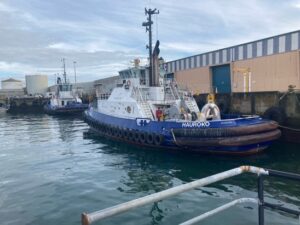 Navigatus was contracted to develop a safety management system (SMS) for navigational safety built upon an existing but dated system of safety management. This project initially involved conducting a risk identification and assessment process for Bluff Harbour on behalf of the Harbourmaster.
Navigatus was contracted to develop a safety management system (SMS) for navigational safety built upon an existing but dated system of safety management. This project initially involved conducting a risk identification and assessment process for Bluff Harbour on behalf of the Harbourmaster.
This project demonstrates Navigatus’ ability to work for both the regulatory authorities and commercial clients in a collaborative and trusting environment. It also demonstrates the ability to build a modern safety management system based upon established practices.
The SMS forms a systematic method to identify and control risk, to assure that these risk controls are effective, and provide the required assurance to the regulatory authority. The SMS facilitates ongoing operations despite the inherent challenges of the harbour.
Cruise Ship Operations: Safety Management System
Role: Develop an operational SMS
Clients: Environment Southland (regional maritime authority)
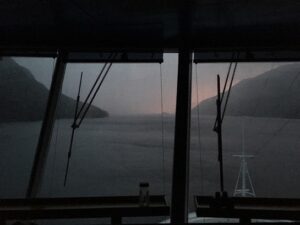
Navigatus was contracted to develop a safety management system (SMS) for the management of cruise ships operating throughout Fiordland.
Fiordland attracts the cruise industry for its spectacular and majestic beauty. This natural but exposed environment, with its complex system of fiords and at times severe environmental conditions, can create notable navigational challenges. This, combined with a significant increase in the number of cruise ship passages during the peak season, was recognised as presenting potentially significant risks. The SMS built upon the existing pilotage plans and SOPS, together with the findings of a number of incidents and the recommendations of an industry working group.
This engagement demonstrates Navigatus’ ability to work for both the regulatory authorities and industry representatives to build upon established practice in response to a changing risk profile
The SMS formed a systematic method to control operational risk, and subsequently became an element of a higher level regional maritime safety management system.
Tory Channel: Risk assessment
Role: Risk assessment of fish farming near RoRo ferry route
Clients: NZ King Salmon
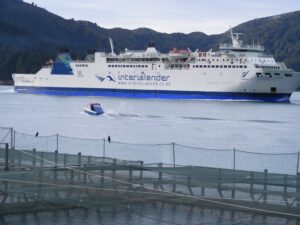 Navigatus was contracted to undertake a navigation risk assessment of a nationally critical transport route as part of the planning application process for the development of large fish farm facilities.
Navigatus was contracted to undertake a navigation risk assessment of a nationally critical transport route as part of the planning application process for the development of large fish farm facilities.
As the proposed fish farms were to be close to an existing ferry route, the planning authorities needed assurance that both the large farm structures would not present a risk to the ferries, and also, that the ferries would not present a risk to the farms.
The risk assessment concluded that, provided the farms were constructed outside of a defined navigation corridor, the width of which as statistically determined, and that the farm support vessels adhered to the existing harbourmaster’s directions, the level of risk would be well within accepted norms. Similar work was done for a number of later farm developments in Tory Channel.
The risk assessment findings and associated reports subsequently formed the basis of refined farm designs or modified planning applications as well as expert witness evidence that in turn helped the farm developments to be approved.
This demonstrates Navigatus’ ability to work with stakeholders that nominally could be competing for water-space, and to apply maritime expertise and advanced mathematical methods to manage risk in the real world.
Milford Sound Safety Management System
Role: Risk identification and assessment
Clients: Environment Southland
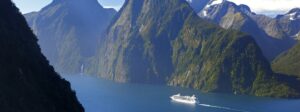 Navigatus was contracted to develop a safety management system (SMS) for the operation of commercial tourist launch fleets. This project involved identification and assessment of hazards, and integration with an existing code of practice. A system of management was developed to ensure the identified risk controls were implemented and maintained as part of everyday operations. Aside from the remote location and extreme weather typical for this exposed location, complexity is created by multi-operator activity carried out in an area not legally designated as a port.
Navigatus was contracted to develop a safety management system (SMS) for the operation of commercial tourist launch fleets. This project involved identification and assessment of hazards, and integration with an existing code of practice. A system of management was developed to ensure the identified risk controls were implemented and maintained as part of everyday operations. Aside from the remote location and extreme weather typical for this exposed location, complexity is created by multi-operator activity carried out in an area not legally designated as a port.
The project, undertaken for the regional harbourmaster, was important and it helps protect a nationally iconic area and the many tourists that visit Milford Sound.
The SMS forms a systematic method to identify and control risk, to assure that these risk controls are effective, and provide a channel for stakeholder engagement in safety management. The system facilitates goal setting, planning, and measuring performance. At the highest level the key SMS elements are:
- Leadership
- Competence
- Supervision
- Control
The project concluded with an agreement between operators in the area to a code of practice.
This demonstrates Navigatus’ knowledge and understanding of the marine environment and the hazards that exist in both a port environment and mid-sized vessel operations, existing methods of control and relevant marine safety legislation.
Port Development Support
Role: Port design support and planning process expert witness
Clients: Various
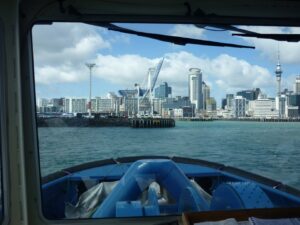 Navigatus are recognised as expert in the field of coastal and navigational safety. Navigatus has been engaged in a peer review, design support and expert witness roles in support of various port expansion projects. Projects include wharf expansion works for ports, assisting port and terminal design teams on a new RoRo berthing facility, re-design of a fast ferry basin, design options for an expanded super-yacht harbour, support to design options for cruise ship berthing dolphins, fishing fleet harbour manoeuvring area sizing and other similar works.
Navigatus are recognised as expert in the field of coastal and navigational safety. Navigatus has been engaged in a peer review, design support and expert witness roles in support of various port expansion projects. Projects include wharf expansion works for ports, assisting port and terminal design teams on a new RoRo berthing facility, re-design of a fast ferry basin, design options for an expanded super-yacht harbour, support to design options for cruise ship berthing dolphins, fishing fleet harbour manoeuvring area sizing and other similar works.
This illustrates Navigatus’ position as a trusted advisor to large commercial port companies, local development agencies and vessel fleet operators and our knowledge of port operations, ship handling and maritime legislation. It also demonstrates Navigatus recognition of the need to understand the overall context, working within existing procedures and directions, identifying risks, supporting engineering design and consulting with various expert groups – sometimes in confidence.
The work undertaken in support of port expansion projects involves office-based, site visits and on-water research to assess the effect of new facilities and operations, changed designs and procedures and navigational risk. Ports operate in a complex maritime environment with often a busy mix of inherently incompatible activity. Navigatus’ experience has consequently involved consideration of concurrent activities such as commercial, naval, power and sail recreational, RoRo operations, cruise ships, tankers, white fleets, tourist launches, fishing fleets, local fast ferry traffic, and even sea plane operations.
Projects invariably involve reviewing; prior risk assessments, early berthing plans and design proposals and opinions from key stakeholders such as maritime pilots. The work requires both a theoretical and a practical understanding of the maritime environment as well as, locally, the full operational context of the ports and harbours involved.
There is also often also a high level of public interest requiring the work to consider the effects on all other port and harbour users, community groups and for the determinations and risk assessments to be able to withstand legal challenge.
Maritime Oil Spill Risk Assessments
Role: Oil spill and transport model development and delivery
Clients: Various state and national agencies
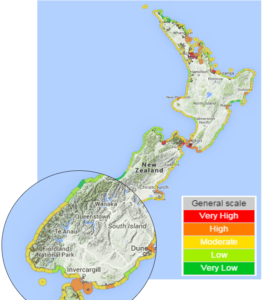
Navigatus have undertaken various marine oil spill risk assessments (MOSRA) for a number of national and state authorities.
The first of these assessments was completed in 2010. Subsequently Navigatus was engaged by the Australian state of Victoria and later again by Maritime NZ to develop a considerably more advanced risk assessment to meet New Zealand’s national legislative obligations. The MOSRA 2015 model reports risk ratings (based on an assessment of consequence, oil spill probability and expected oil exposure) for 20km lengths of coastline along the entirety of New Zealand. The model made the best use of MNZ and both international and national data sources whilst recognising the gaps and limitations in the data.
A later similar engagement for the state of West Australia allowed the model to be further developed – this advanced model is now known as the “Osprey” model. This model has been applied to the New South Wales coastline and areas in the Middle East.
These projects enable agencies to focus readiness and response capabilities and determine marine oil spill prevention, preparedness and response resourcing and activities. See Services for more information on Navigatus’ ‘Osprey‘ oil spill risk model.
Public facing MOSRA web link:
Safety Management of Open-Ocean Aquaculture Facilities
Role: Development of Safety Management System and advice on design of farm structures and support vessels
Clients: New Zealand King Salmon
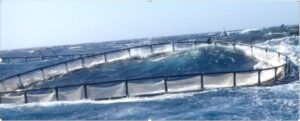
This project was commissioned in support of the first truly open-ocean fish farm development in the Southern Hemisphere. It involved assessment of the level of navigational and safety risk associated with a proposed salmon farm site in the, at times, extreme conditions of the Cook Strait. Navigatus considered international best-practice and standards, as well as the additional demands of the site including the heightened tsunami threat associated with the Pacific Ring of Fire. Given the national maritime rules in place were not written with such farms in mind, use of Rule 40G (Novel Vessels) enabled a Safety Management System to be proposed together with international maritime classification.
This risk assessment considers risk from two perspectives; risk from the presence of the farms in navigational waters and the potential for risk to vessels resulting from failure of the structural arrangements of the farms. Similar consideration was given to support barges and the effect of the exposed and remote site on safety and workability.
The risk assessment involved the following steps:
- Understanding the context – identification of key stakeholders
- Identification of risks – through consultation with stakeholders and experts’ professional experience, investigations of cage designs and site visits
- Consultation with key expert stakeholders, potential designers suppliers and enquires with classification societies.
- Analysis and assessment of risk – this report forms the analysis and assessment of risks (expressed in relative terms) based on information received from steps above.
This project shows Navigatus’ position as a trusted advisor to to the marine safety sector, and demonstrates our ability to work within the limitations of the existing rule set, knowledge of marine and aquaculture legislation and expertise in safety management systems.
Other Example Projects
Risk analysis / assessment:
- Recovery of the MV KEA TRADER (Ardent Maritime BV) – risk analysis of salvage options for salvage of the MV KEA TRADER and development of MV KEA TRADER crew evacuation processes
- Western Australian Marine Oil Pollution Risk Assessment (Government of Western Australia Department of Transport) – state wide marine oil spill risk assessment
- Maritime Sector Environmental Scan (Maritime New Zealand) – analysis of current and future trends affecting oil spill risk in New Zealand waters
- Victorian Marine Pollution Risk Assessment and Coastline Risk Profile (Victoria State Government Department of Transport) – state wide marine oil spill risk assessment
- Fiordland Cruise Ship Risk Assessment (Environment Southland) – risk assessment for Fiordland cruise ship operations based upon navigational complexity, physical and environmental hazards, traffic density, nature of operations / passages and types / sizes of vessels
- Bow tie risk analysis of navigation of large vessels (Port Otago Limited)
- Marine risk assessment of navigation of Suezmax tankers along proposed dredged port entry channel (Refining NZ)
- Safety risk analysis of main engine turbocharger failure (Royal New Zealand Navy)
- Safety analysis of regulatory interventions (Australian government agency).
Maritime Operational Safety
- Auckland Ferry Basin Redevelopment (Auckland Transport) – operational risk analysis for the relocation of Pier 3 and 4
- Navigational Risk Assessment – Capital Dredging of Rangitoto Channel, FN berth and approaches (Ports of Auckland) – reviewed navigational aspects of submissions, prepared navigational safety evidence and delivered evidence at the Council hearing
- Maritime Navigational Safety – Fishing Fleet Simulator and Sea Trial Development and Support (Panuku Developments) – operational risk analysis for the relocation of an Auckland fishing fleet
- Sealink Ferry Terminal – Maritime Navigation Support (Panuku Developments) – operational risk advice for the design and construction of a RoRo ferry terminal
- Open-water Aquaculture Developments (New Zealand King Salmon) – Navigational risk assessment and development of a navigational risk assessment framework
- Fiordland Safety Management System (Environment Southland) – development of maritime safety management framework
- Safety Advice and Support – RENA Recovery Operations (Svitzer Salvage Ltd) – development of SMS for MS RENA recovery related operations
- Risk analysis of navigation channel development for Suezmax tankers (Refining NZ)
- Fiordland Cruise Ship Safety Management System Review (Environment Southland) – development of cruise ship operations SMS for Milford Sound
- Fiordland Safety Management System (Environment Southland) – development of SMS for Fiordland and Stewart Island
- Western Australian Marine Oil Pollution Risk Assessment (Government of Western Australia Department of Transport) – state wide risk profiling and maritime hazards assessment
- Otago Harbourmaster Service (Otago Regional Council) – maritime safety support as harbourmasters
- America’s Cup 36 (AC36) Support – Maritime Navigational Safety (Panuku Developments) – navigational risk assessment and maritime expert to planning process for AC36
- Risk profiling and study of Harbour Master and wreck removal liability and insurance requirements (Region Councils CEO forum)
- Organisational risk assessment maritime and aviation (Far North Holdings Ltd)
- Marine Oil Spill Risk Assessment (MOSRA10, MOSRA15; Maritime New Zealand) – national maritime oil spill risk profiling
- New South Wales Marine Pollution Risk Assessment (Transport for New South Wales) – state maritime oil spill risk profiling
- National navigational risk profiling (Maritime NZ).
Project related assignments:
- Bluff Harbour Risk assessment / SMS (SouthPort / Environment Southland) – completion of a risk assessment for Bluff Harbour followed by the development of a combined Harbour SMS
- America’s Cup 36 (AC36) Support – Maritime Navigational Safety (Panuku Developments) – AC36-related navigational design requirements and support to resource management application
- Sealink Ferry Terminal – Maritime Navigation Support (Panuku Developments) – navigational design support for the construction of a RoRo ferry terminal
- Auckland Ferry Basin Redevelopment (Auckland Transport) – provided specialist navigational safety advice to inform the design and resource consent processes
- Recovery of the MV KEA TRADER (Ardent Maritime BV) – Operations Manager for salvage of MV KEA TRADER
- Navigational Risk Assessment – Capital Dredging of Rangitoto Channel, FN berth and approaches (Ports of Auckland) – reviewed navigational aspects of submissions, prepared navigational safety evidence and delivered evidence at the Council hearing
- South Taranaki Bight Iron Sand Mining Marine Consent (Trans-Tasman Resources Limited) – maritime expert witness for EPA process
- Various aquaculture projects (New Zealand King Salmon) – maritime expert witness for EPA process
- Safety Advice and Support – RENA Recovery Operations (Svitzer Salvage Ltd) – safety officer for MV RENA slavage and recovery and development of SMS for MS RENA recovery related operations
- Maritime expert witness for planning process – Channel development for Suezmax tankers (Refining NZ)
- Design of main engine turbocharger failure capture devices (Royal New Zealand Navy)
Business process and systems risk:
- Support to Royal Australian Navy N4 Library Re-Write (Bureau Veritas)
- Development of Port and Harbour Safety Code package (Otago Regional Council/Port Otago)
- Fiordland Safety Management System (Environment Southland) – development of SMS for Fiordland and Stewart Island
- Review of Port, Harbour and other water in the Otago region – Navigational Safety (Otago Regional Council)
- Fiordland Cruise Ship Safety Management System Review (Environment Southland) – development of cruise ship operations SMS for Milford Sound
- Development of tourist launch operations Safety Management System (Environment Southland)
